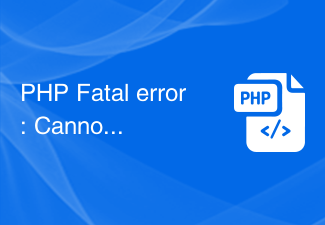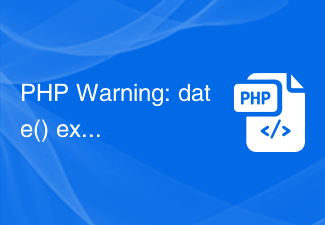
How to solve Java thread interruption exception (InterruptedException)
The thread interruption exception (InterruptedException) in Java is when a thread is waiting (sleep), waiting to acquire a lock ( Exceptions thrown by other threads during operations such as wait) and waiting for semaphores (signal). The occurrence of this exception means that the current thread is interrupted from the normal execution flow. In actual development, we need to handle this exception reasonably to ensure the stability and reliability of the program.
The main methods to solve Java thread interruption exceptions are as follows:
- Restore interruption status
When a thread encounters a thread interruption exception, the exception will be thrown and Clear the interrupt status (clear the interrupt flag bit to zero). Before handling the exception, you can use theThread.currentThread().isInterrupted()method to determine whether an interruption has occurred, and then decide whether to ignore the exception or perform further processing based on the specific situation. If you need to continue to maintain the interrupt status, you can call theThread.currentThread().interrupt()method to reset the interrupt status before exception handling.
The following is a simple code example:
Thread thread = new Thread(() -> {
try {
// 线程执行一些耗时操作
for (int i = 0; i < 10; i++) {
System.out.println("执行中断操作 " + i);
Thread.sleep(1000);
}
} catch (InterruptedException e) {
// 捕获中断异常
System.out.println("线程被中断了");
// 恢复中断状态
Thread.currentThread().interrupt();
}
});
thread.start();
// 主线程休眠2秒后中断子线程
Thread.sleep(2000);
thread.interrupt();In the above code, the child thread executes a loop, and each loop performs a time-consuming operation (sleep 1 second). The main thread sleeps for 2 seconds and then interrupts the child thread. When the child thread catches the interrupt exception, we use the interrupt() method to reset the interrupt status.
- Continue to throw exceptions to the upper layer
Sometimes, we do not want to restore the interrupt state when an interrupt exception occurs, but we want to continue throwing exceptions to the upper layer. In this case, the exception can be thrown directly to the upper layer for processing.
The following is a sample code:
Thread thread = new Thread(() -> {
try {
// 线程执行一些耗时操作
for (int i = 0; i < 10; i++) {
System.out.println("执行中断操作 " + i);
Thread.sleep(1000);
}
} catch (InterruptedException e) {
// 直接向上层抛出异常
throw new RuntimeException("线程中断异常", e);
}
});
thread.start();
// 主线程休眠2秒后中断子线程
Thread.sleep(2000);
thread.interrupt();In the above code, when the child thread catches the interrupt exception, we use throw new RuntimeException("Thread Interruption Exception" , e)Continue to throw exceptions to the upper layer.
- Exit gracefully
In some cases, we want to exit gracefully after the thread is interrupted. In terms of implementation, you can add a flag bit to determine whether an interrupt has occurred and exit the thread at the appropriate time.
The following is a sample code:
class MyThread extends Thread {
private volatile boolean isInterrupted = false;
public void setInterrupted(boolean interrupted) {
isInterrupted = interrupted;
}
@Override
public void run() {
try {
// 线程执行一些耗时操作
for (int i = 0; i < 10; i++) {
if (isInterrupted) {
System.out.println("线程被中断了");
return;
}
System.out.println("执行中断操作 " + i);
Thread.sleep(1000);
}
} catch (InterruptedException e) {
System.out.println("线程被中断了");
return;
}
}
}
MyThread thread = new MyThread();
thread.start();
// 主线程休眠2秒后中断子线程
Thread.sleep(2000);
thread.setInterrupted(true);In the above code, we customized a thread class MyThread and added a isInterrupted flag. During the execution of the child thread, the flag bit is judged to determine whether to exit the thread.
To sum up, to solve Java thread interruption exceptions, you can restore the interruption status, continue to throw exceptions to the upper layer, or exit gracefully. The specific choice should be determined based on specific business needs and scenarios. Properly handling thread interrupt exceptions is an important part of ensuring program stability and reliability, and needs to be designed appropriately based on the actual situation.
The above is the detailed content of How to solve Java thread interrupt exception (InterruptedException). For more information, please follow other related articles on the PHP Chinese website!
 PHP Warning: mysqli_query(): Empty query的解决方法Jun 22, 2023 pm 04:45 PM
PHP Warning: mysqli_query(): Empty query的解决方法Jun 22, 2023 pm 04:45 PM在使用PHP开发Web应用时,经常会遇到各种各样的问题。其中,一些常见的问题是与MySQL数据库相关的问题。有一种问题是“PHPWarning:mysqli_query():Emptyquery”的错误。本文将介绍此错误的原因以及解决方法。首先,让我们看看这个错误表示什么。当您使用mysqli_query函数执行MySQL查询时,如果该查询为空,则会
 PHP Fatal error: Cannot redeclare的解决方法Jun 22, 2023 pm 07:43 PM
PHP Fatal error: Cannot redeclare的解决方法Jun 22, 2023 pm 07:43 PM在使用PHP进行开发的过程中,有时候会遇到“PHPFatalerror:Cannotredeclare”错误,这个错误通常会出现在如下情况:在PHP代码中多次include/require同一个文件。在代码中定义了和已有的函数/类重名的函数/类。这个错误会导致程序无法继续执行,为了解决这个问题,我们需要了解其产生原因和解决方法。产生原
 PHP Notice: Undefined property: stdClass::$的解决方法Jun 22, 2023 pm 10:24 PM
PHP Notice: Undefined property: stdClass::$的解决方法Jun 22, 2023 pm 10:24 PM在使用PHP编写代码时,我们经常会看到这样的错误提示:“PHPNotice:Undefinedproperty:stdClass::$”。这个错误提示通常是由于在使用对象的属性时,该属性不存在而引起的。在本文中,我们将讨论如何解决这个问题。首先,我们需要了解这个错误提示的原因。当我们使用对象的属性时,PHP会首先检查该属性是否存在。如果该属性不存在,
 PHP Warning: date() expects parameter 2 to be long, string given的解决方法Jun 22, 2023 pm 08:03 PM
PHP Warning: date() expects parameter 2 to be long, string given的解决方法Jun 22, 2023 pm 08:03 PM在使用PHP程序开发时,经常会碰到一些警告或者错误的提示信息。其中,可能出现的一个错误提示就是:PHPWarning:date()expectsparameter2tobelong,stringgiven。这个错误的提示信息意思是:函数date()的第二个参数期望是长整型(long),但是实际传递给它的是字符串(string)。那么,我们
 PHP Notice: Trying to get property ‘的解决方法’ of non-object的解决方法Jun 22, 2023 am 11:51 AM
PHP Notice: Trying to get property ‘的解决方法’ of non-object的解决方法Jun 22, 2023 am 11:51 AM当我们在使用PHP进行开发时,有时会遇到”Tryingtogetproperty‘的解决方法’ofnon-object”的错误提示。这个错误的原因一般是因为程序中对一个不存在或者未实例化的对象进行访问,导致了PHP解析器无法识别该对象的属性或方法。那么,如何解决这个错误呢?下面我将为大家介绍几种可能的解决方法。一、检查代码首先,我们需要将出错的代
 TranslucentTB不起作用:如何解决Jun 06, 2023 am 08:21 AM
TranslucentTB不起作用:如何解决Jun 06, 2023 am 08:21 AMTranslucentTB是寻求时尚简约桌面外观的Windows11爱好者广泛使用的工具,遇到了障碍。自从发布以来Windows11内部版本22621.1344(22H2)28年2023月日,TranslucentTB对大多数用户不起作用。此错误使用户努力应对其任务栏的有限自定义选项。用户在寻求克服这一挫折的解决方案时,挫败感显而易见。在最近的Windows11更新之后,TranslucentTB无法正常工作的问题已在多个在线平台上广泛报道,包括论坛和社交媒体。用户一直在分享他们的经验,拼命寻找
 PHP Notice: Undefined index:的解决方法Jun 22, 2023 am 10:15 AM
PHP Notice: Undefined index:的解决方法Jun 22, 2023 am 10:15 AM当使用PHP开发Web应用程序时,经常会遇到“PHPNotice:Undefinedindex:”这样的错误消息。此错误消息通常与数组相关。在PHP中,当我们使用未定义的数组索引时,就会收到这种类型的错误消息。这通常会发生在以下情况下:尝试访问不存在的数组元素尝试使用错误的键来访问数组在本文中,我们将探讨如何解决此错误,并提供一些常见的应用程序开发实践
 PHP Notice: Undefined property: stdClass::$name的解决方法Jun 22, 2023 pm 10:09 PM
PHP Notice: Undefined property: stdClass::$name的解决方法Jun 22, 2023 pm 10:09 PM在使用PHP开发项目时,经常会遇到各种警告和错误信息。其中,PHPNotice:Undefinedproperty:stdClass::$name是比较常见的一种警告提示。这种提示通常出现在尝试访问一个对象属性,但该属性并不存在的情况下。本文将介绍这种警告的解决方法。原因分析在PHP中,stdClass是一个类似于数组的标准类,在没有指定类的情况下创


Hot AI Tools

Undresser.AI Undress
AI-powered app for creating realistic nude photos

AI Clothes Remover
Online AI tool for removing clothes from photos.

Undress AI Tool
Undress images for free

Clothoff.io
AI clothes remover

AI Hentai Generator
Generate AI Hentai for free.

Hot Article

Hot Tools

EditPlus Chinese cracked version
Small size, syntax highlighting, does not support code prompt function

Dreamweaver CS6
Visual web development tools

WebStorm Mac version
Useful JavaScript development tools

SublimeText3 Mac version
God-level code editing software (SublimeText3)

DVWA
Damn Vulnerable Web App (DVWA) is a PHP/MySQL web application that is very vulnerable. Its main goals are to be an aid for security professionals to test their skills and tools in a legal environment, to help web developers better understand the process of securing web applications, and to help teachers/students teach/learn in a classroom environment Web application security. The goal of DVWA is to practice some of the most common web vulnerabilities through a simple and straightforward interface, with varying degrees of difficulty. Please note that this software






